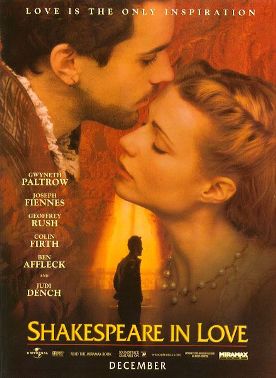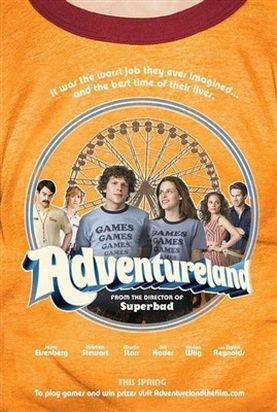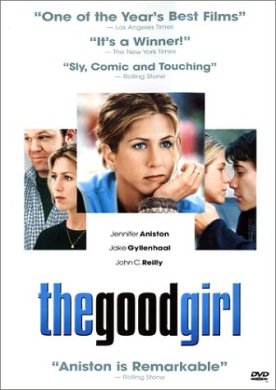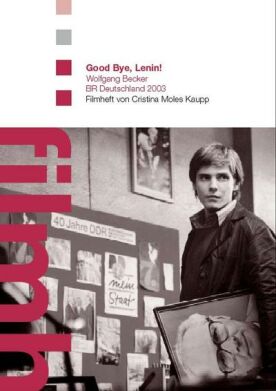Shakespeare in Love
Shakespeare in Love, which was directed by John Madden from a screenplay co-written by Tom Stoppard, has all the signs of the high Stoppardian style, including lots of puns and Elizabethan English transplanted to unexpected situations, where it takes on new and usually humorous meanings. And not only Elizabethan words either. At one point we see the theatre owner and impresario, Philip Henslowe (Geoffrey Rush) lamenting the closing of his theatre by the Lord Chamberlain (Simon Callow) on the very eve of the Shakespearean production of Romeo and Juliet, which he hopes will repair his theatrical and (especially) his pecuniary fortunes. So dismayed is he by this turn of events that he cannot get the words out: “The show,” he stutters, “the show must —” and he gags on the words.
“Go on,” urges his interlocutor.
Of course these jokes wrought through more or less artificially contrived conjunctions of ideas and catch-phrases familiar from our own time and the otherwise overwhelming strangeness of Elizabethan England are all very knowing and even postmodern in style, and no effort is wasted on mere plausibility. Thus Shakespeare (Joseph Fiennes) has on his desk a souvenir mug from Stratford-on-Avon. Or, in my favorite example, the waterman who ferries this Shakespeare across the Thames to the home of the beautiful daughter, Viola DeLesseps (Gwyneth Paltrow), of a rich merchant, tells him, “I had that Christopher Marlowe in the back of the boat once” and ends by saying, “Writer, huh? Funny, but I’m a bit of a writer myself,” and tries to hand him a play.
This is a broad sort of humor, but definitely for a sophisticated taste. And the intellectual humor to which it so naturally extends depends for its effect upon a pretty thorough knowledge of the works of Shakespeare. The film is really a non-stop procession of words and phrases, characters and situations, which the author, allowing fancy a free rein, proposes as the raw material for the plays which are in fact (almost) all we really know of Shakespeare. Thus Shakespeare himself and the delightful Miss DeLesseps are imagined as the models for the star-cross’d lovers, and we see them improvising on raw reality — or theatricality — until it becomes recognizably Shakespearean. So, too, do even the smallest everyday actions, as Shakespearean lines are constantly coming up in unexpected contexts. A man walks into a bar and says, “Give me to drink Mandragora.”
But the finished Shakespearean product usually requires several drafts. The earliest version of Romeo and Juliet is titled, Romeo and Ethel the Pirate’s Daughter and involves a performing dog. “Love and a bit with a dog, that’s what they want,” says Henslowe of his audience through his few, crooked and moss-covered teeth. He is deeply disappointed when Shakespeare thinks better of the canine element ( “no dog of any kind?” he asks, crestfallen). Later the play briefly becomes Romeo and Rosaline until the model for Rosaline is found in bed with the Lord Chamberlain. Likewise, a first draft of the tender scene between the lovers after their night of passion, originally played out by Shakespeare and Miss DeLesseps has them arguing playfully about whether it was the owl of night or the rooster of morning that they have heard, and it is only subsequently that these birds become the more evocative nightingale and the lark of the play.
Such stuff is of course entirely speculative, even whimsical, like a Shakespearean word game or quiz show. More seriously, the film seems to conclude that in real life, Juliet would have married County Paris — here represented as a fictional Lord Wessex (Colin Firth) — and that neither she nor Romeo are, after all, quite up to killing themselves for love. Such things, it seems to be wryly suggested, only happen in the movies. But this movie represents Shakespeare as above all a man of the theatre, and Geoffrey Rush’s performance as the impresario, Henslowe, is in many ways the most memorable thing about it, particularly when he teams up as a double act with the thuggish money-lender, Fennyman (Tom Wilkinson) who becomes completely stage-struck on being offered the small part of the Apothecary.
In fact, the whole film represents modern commercialism gone stage-struck. The climax of the action comes in the theatre as Queen Elizabeth herself (Judi Dench) witnesses the scandal of the role of Juliet being played by a woman, and the second heavy (after the vain and stupid Wessex, bound for Virginia on the assumption that “tobacco has a future” ) is the young John Webster, seen as a boy who enjoys torturing small animals. Christopher Marlowe (Rupert Everett) also plays an important part, outlining for his blocked friend Shakespeare all the masculine, political elements of the play’s basic scenario before proceeding to his inevitable end ( “I’m for Deptford,” he says jauntily on his way out the door). All this is marvelously clever and far, far more amusing than your average postmodern movie, but it is hard to shake off the sense that it has quite as few points of connection with reality.
Discover more from James Bowman
Subscribe to get the latest posts to your email.







